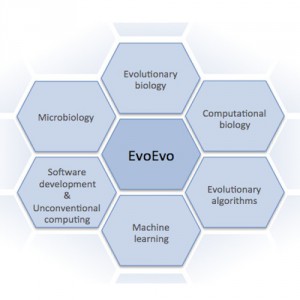About EvoEvo project

We will start from experimental observations of micro-organism evolution, and abstract this to reproduce EvoEvo, in biological models, in computational models, and in application software. Our aim is to observe EvoEvo in action, to model EvoEvo, to understand EvoEvo and, ultimately, to implement and exploit EvoEvo in software and computational systems.
The EvoEvo project will have impact in ICT, through the development of new technologies. It will also have impact in biology and public health, by providing a better understanding of micro-organism adaptation (such as the emergence of new pathogens or the development of antibiotic resistances).
Objectives
2. Simulate “evolution of evolution” in a computational framework. The simulations will use individual-based models that will help analysing the results of the evolution experiments. They will help us proposing hypotheses on the structural roots of EvoEvo at the levels of genetic sequences, regulation and metabolic networks and cell populations. The models will also constitute the basis of the computational evolutionary platform. EvoEvo will contribute computational biology by the development of integrated computational evolutionary models that will be made available for the scientific community.
3. Design a computational evolution platform to exploit EvoEvo in applicative software. This platform will be directly inspired from the in silico models but both simplifications and generalizations will be made. The former will remove from the models all the biological specificities that are not useful to exploit EvoEvo. The later will enable the framework to be used in different applicative contexts. EvoEvo will contribute evolutionary computation by the development of a new framework that will use evolution of evolution at its heart.
4. Apply EvoEvo to real ICT problems. Two applications of increasing difficulty will be proposed. The ability to exploit effectively EvoEvo in these applications will constitute the final proofs of concept that evolution of evolution can drive future technologies in an efficient way. EvoEvo will propose proofs of concept showing the power of the principles developed in the project.
EvoEvo’s route from the biological domain to the living-technologies application domain.
Approach
Variability
Variability is the ability to generate new phenotypes, by mutations or by stochastic fluctuations. It is a necessary condition for any evolutionary process to take place. However, in biological organisms, the amount of variability is controlled by complex pathways that e.g. correct DNA mismatches or breakings. In an ICT context, evolution of variability could help the evolving system to quickly discover new solutions either on a transient or on a stable way through efficient exploration of the functional space. Moreover, in real biological systems, mutational operators are highly diversified, including point mutations, but also large chromosomal rearrangements that can rapidly reshuffle the chromosome organization, extend or reduce the gene repertoire of an organism or even duplicate its entire genome through whole genome duplication.
Robustness
Although mandatory, variability is a very dangerous process since it permanently produces deleterious mutations that lead to mal-adapted individuals. Robustness may evolve to correct these deleterious effects. It enables evolving systems to support mutational events without loosing fitness through e.g. canalization or the selection of structures that creates neutral landscapes. In an ICT context, selection of robustness may favours the emergence of “organism” structured such that the service will not be perturbed by the random occurrence of mutational events.
Evolvability
Depending on the genotype-to-phenotype mapping, the proportion of deleterious/neutral/favourable mutational events may change. Evolvability is the ability of a specific genotype-to-phenotype mapping to increase the proportion of favourable events. This can be done by the selection of specific genome structures or by the selection of specific networks structures. In an ICT context, evolvability will enable evolution to make profit from the past events to increase the system ability to adapt to new users or conditions.
Open-endedness
Biological evolution is not directed towards a specific target. On the opposite, evolution has the ability to generate new challenges while evolving by e.g. exploiting new niches created by the evolution of other species. In an ICT context, open- endedness can but exploited when an application is made by an ecosystem of evolving individuals. In such a structure, new functions will arise continuously by emergence of new species in the ecosystem and/or the extinction of maladapted ones.
Approaches towards EvoEvo: four characteristics of the genotype-to-phenotype mapping will be studied in real organisms, modeled through computational evolution and implemented in an applicative platform.
Work plan
EvoEvo aims at achieving its objectives through a workplan containing 6 workpackages: WP6 management; WP1 in vivo experiments; WP2 model design; WP3 in silico experiments; WP4 computational framework design; WP5 applications. Figure herebelow illustrates the essential characteristics of the project and the way their declination in the workplan ensures that the global objectives are achieved.
Principle 1 A route from evolutionary biology (WP1) to artificial evolution (WP4) through modelling (WP2).
Principle 2 Parallelism between in vivo experimental evolution (WP1) and in silico experimental evolution (WP3).
Principle 3 Applicative targets (WP5) that will make profit from both the computational framework designed in WP4 and from EvoEvo knowledge produced in WP3.
Work packages components

Background image - Young Tree, 1932, Paul Klee




